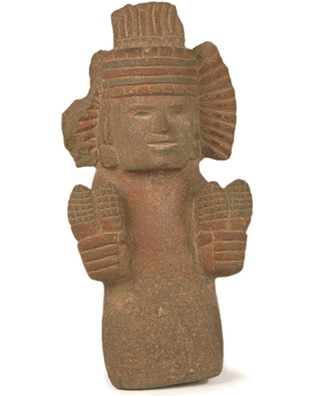 loading
loading
Arts & CultureA goddess for Josef AlbersObject lesson Mary Miller ’81PhD is the dean of Yale College and Sterling Professor of the History of Art.  Yale Peabody MuseumView full imageJosef and Anni Albers came to the United States in 1933 from Germany after Hitler had shuttered the Bauhaus, the great design school founded by Walter Gropius. Starting in 1934, the Alberses would drive from Black Mountain College to Mexico in the summers, stopping to study color and weaving techniques, according to their respective interests, and making a collection of pre-Hispanic art of Mexico. When Josef Albers joined the Yale School of Art faculty in 1950, the annual pilgrimages to Mexico ceased, but the interest in the art of the ancient Americas thrived. Anni Albers would study with George Kubler, professor of art history; Josef Albers would strike up a great friendship with Michael Coe, professor of anthropology. Josef Albers’s work and painting flourished; he made most of his most famous color-theory works, the Homage to the Square paintings and prints, while on the faculty. Anni Albers, too, achieved some of her greatest success, particularly with her woven South of the Border of 1958. Because of the relationship with Coe, Josef Albers would ultimately endow a traveling fellowship for study of ancient American art, a fund that has supported dozens of students in anthropology, art history, and more; he would also give his collection of pre-Hispanic art to the Peabody Museum. Now several works in the Albers collection have found a new home in the transformed and expanded Yale University Art Gallery. The single most important object from the Albers collection is an Aztec maize goddess, featured here, who is exhibited on the first floor of the gallery alongside other important Aztec stone objects from the Peabody Collection. The maize goddess is a common subject of Aztec sculpture, and this example probably held an important place in a regional shrine. Made of red tezontle, the lightweight and easily shaped Aztec stone from volcanic flows in central Mexico, this female image, like most Aztec maize deities, holds two ears of maize in each hand. Traces of paint bring the headdress and doubled ears of maize to life, alternating red and blue, the cobs much like those in painted examples in surviving manuscripts from the era of the Spanish invasion; this sculpture was probably made within one or two decades of the cultural cataclysm that began in 1519 and that quickly brought Aztec image-making to a close. But the folded paper fan that frames the sides of this goddess’s head tells us that she is also associated with water, that she brings the water that makes it possible for maize to thrive. In this, the Albers sculpture honors a goddess who could be attended and honored over the life of maize, from germination to harvest. Maize deities usually stand and water deities kneel; this carved figure seems to kneel. Nevertheless, a careful examination may tell another story. Although the figure was once nearly fully painted, the paint stops abruptly at the level of the waist. What this suggests to me is that this sculpture was once part of a larger setting, perhaps set in wood or as part of a shrine, but perhaps set so that the sculpture could play different roles in different seasons, as maize kernels grew with nourishing rain into tender plants, at last yielding the flint-hard ears that formed the staff of life as tamales and tortillas. Most Mesoamerican peoples believed that the gods formed humanity from maize and then gave it life through their own sacrifice. A work like the Albers maize goddess would have been fundamental to Aztec religious ritual and practice. Today we can understand something of this practice through the work itself. And we can see the traces of brilliant color that must have called to Josef Albers. On an upper floor of the Art Gallery visitors can see some of the colors that Albers painted, printed, studied, and analyzed, much like the pigments on this very work.
The comment period has expired.
|
|